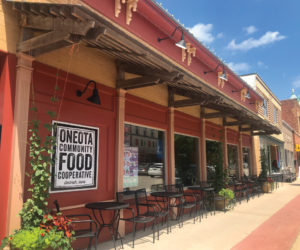By: Liz Rog – Co-op Member/Owner
On perfect spring days such as these, one can almost believe that our little piece of paradise here in NE Iowa is a world apart, destined to always blossom in just this way, every spring, forever. But of course we do not, in the end, live in a bubble. Our home is subject to the same threats to its land, water, air and culture as any other place. Our fates are all intertwined.
For nearly 40 years our Co-op, its members and community members have been leaders in efforts to protect the water, land and air of our region. The Co-op has nurtured connections between consumers and local farmers, and helped to connect people’s concern for the living earth with the food choices we make. It has celebrated the rich farmland, the abundant waterways and the creative, cooperative instincts of people. It has strengthened the local food system in ways unimaginable just a few decades ago. In the process, the Co-op has helped create an environment that attracts young people, many of whom are staying or returning to share their energy and good will. Visitors marvel at the strength of the local economy, the local foods and the many ways to enjoy the water, air, and land.
A proposed new industry threatens to change this.
Often now called “frac sand” because of its connection to the hydraulic fracturing process which extracts natural gas from the ground, silica sand has been found in abundance where we live. For this reason, our hills have suddenly become extremely valuable to multinational gas and oil corporations.
A Place Nearby
We don’t have to look far to see a living example of how quickly the change could come. Over the past 2 years alone, our neighbors in SW Wisconsin have watched the opening of 112 new silica sand mines, ranging in size from 300 to 1200 acres.1 These hills are driven away in huge trucks that travel the winding county roads, passing by rural farms and homes every 15-30 seconds. Their ground water is potentially polluted with acrylamide and their air potentially polluted with cancer-causing respirable crystaline silica (silica dust)2.
On October 1, 2012, Allamakee county residents learned that an application had been submitted to open a large-scale mine. Within the month, residents formed the Allamakee County Protectors. This citizens group worked quickly and successfully to promote an 18-month moratorium and continue to work non-stop to educate themselves and others about this new local issue. In sparsely-populated Allamakee County, hundreds of people have shown up at meetings to express their support for banning, or at least limiting, frac sand mining.
On February 4, 2013 the Allamakee County supervisors passed an 18-month moratorium on this type of industrial silica mining. However, it remains to be seen what will come next. In 2014 will frac sand mining begin in that wild, fertile, and majestic land? In whose backyard will it be allowed? Who will watch over these huge mines to see if they are complying with regulations? How will the roads be repaired?
Many feel that once the door is opened, the mines will be unstoppable. Some refer to Wisconsin as an example of this. Many wonder how we could possibly risk poisoning the groundwater aquifer that supplies hundreds of thousands of people and countless farms. Many question what benefit the county citizens could ever realize—for even if there were financial benefit realized for the county, how could it outweigh the damage to the ecosystem and culture for future generations?
In This Place
On May 14th, over 170 people filled the Winneshiek County courtroom as the Planning and Zoning Commission met to discuss a proposed moratorium in this (Winneshiek) county. At one point in the meeting, a speaker asked that all those who were in favor of the moratorium stand. It was a moving moment, as practically the whole room arose. A petition with 1,350 signatures of Winneshiek County citizens in support of the moratorium was presented, and by a vote of 8-1 the commissioners recommended an 18-month moratorium to the Winneshiek County Board of Supervisors. At least 2 commissioners commented after the meeting that they had voted for the moratorium only because of the strong showing of citizen support at the meeting and through letters, calls, and signatures. That’s the way it’s supposed to work.
The next step in Winneshiek County is to help the Supervisors to pass the moratorium. Local citizens are preparing to support their binding vote which may take place as early as this June. Citizens’ voices must be heard.
One group that has been leading the way since February 2013 and will continue to work diligently toward a solution is the Winneshiek County Protectors (WCP). It has worked quickly and effectively toward establishing the moratorium. WCP has gathered and distributed important data on the economic, environmental and health effects of industrial-scale silica mining, and coordinated the collection of 1,350 signatures for the petition. WCP hopes to work with pubic officials during the moratorium to revise the county’s comprehensive plan to regulate the scope, scale, and impact of this kind of mining on the county’s infrastructure, on the health of residents and on existing economic activities.
Many local citizens are gathering in living rooms, church basements, Deli and school auditoriums to learn and to decide how we will work together to exercise the community’s right to define its own future. Some will seek to create regulations for this new industry, while others will seek to create ordinances preventing activities that harm our shared air, water, and land. Some will pray, some will take care of the children, and some will watch from the sidelines, ready to contribute in other ways at other times. Some may respond, as 35 Catholic Workers did in Winona on April 29 to protest frac sand activities in their region, with civil disobedience. Whatever each of us chooses, in the process we will meet our neighbors and we will become better at listening, speaking up and leading. We will perhaps become more aware of all there is to lose, and live in humble gratitude for what we have known and what we seek to preserve.
It Gets Gritty
In January 2012, President Obama called America the ‘Saudi Arabia of natural gas.’3 Many industry and other players agree. According to Rich Budinger, president of the Wisconsin Industrial Sand Association, our region sits on world-class frac sand deposits that play an essential role in gas extraction.4 That’s why the biggest players on the planet want to mine our sand and transport it around the globe on trucks, trains, barges, and ships.
There have been few threats as capable of quickly diminishing the quality of life for all beings in this region.
Unfortunately, according to a report on silica sand released by the Minnesota Environmental Quality Board in 2013, “No commonly accepted analytical testing methods have been developed for the chemicals of potential concern (i.e. flocculants) and very few commercial laboratories offer testing for these chemicals. Despite there being no commonly accepted analytical testing method, Chippewa County, Wisconsin has required mines to test groundwater and waste material (clay and silt particulate) for acrylamide.”5 Though some counties in SW Wisconsin have passed regulations that attempt to lessen the possible amount of water and air pollution caused by such large-scale mining, 80% of the dozen frac sand facilities that DNR air management engineer Marty Sellers visited were found to be out of compliance with local regulations.6 Sufficient staffing to monitor the mines appears to be an additional issue that will only increase as more mines are proposed and opened. Residents’ land values have plummeted because no one wants to live near the mines. Roads and bridges are ravaged, as just one truckload of silica sand has the effect of as many as 9,600 cars – depending on the size of truck and load.7,8
All of this, to send the sand off around the world to aid in a process of natural gas extraction called hydraulic fracturing, or ‘fracking.’ Fracking, large-scale underground horizontal drilling to release gas deposits, potentially causes yet more poisoning, community unrest, and serious illness in the citizens who live there. The process of fracking has even been connected with an increase in earthquakes.9
Some feel that we have no right to speak out about this issue since we use natural gas. But on the locomotive we call fracking, the ‘need’ for more fossil fuels is but a phantom engineer. The real driver of natural gas extraction is our allowing a tiny minority of us (energy corporation executives) to make key energy policy decisions for us, for We the People. We citizens are in fact eager to embrace conservation, renewable energy and local sustainable production of energy. If we accept the story that we “need” more energy, we accept a simplistic explanation designed to keep us powerless.
Those who speak in favor of this large-scale silica mining are in a position to gain huge monetary wealth from its extraction. These include mine owners, explosives operators, and trucking companies. Selling to a frac sand mine can be a bonanza for a few lucky landowners for with the new mines come promises of jobs and economic stimulus for the small towns and rural areas nearby. But in the May 2013 report “The Economic Benefits and Costs of Frac-Sand Mining in West Central Wisconsin,” prepared for the Wisconsin Farmers Union, Wisconsin Towns Association, and the Institute for Agriculture and Trade Policy, we learn that the economic boom comes only for a very few players—mostly from out of state—and that the local people only lose. Their air, water and land are irreparably harmed. Once-vibrant communities disintegrate as noise, dust, and powerlessness drive away those who had once contributed their energies toward local conviviality.
Though there is much of this particular sand in Winneshiek and Allamakee Counties, currently the only mining of silica sand is on a small scale and provides for traditional local needs related to farming and road cover. However, due to the boom in the world market and the moratoria on frac sand mining in other parts of our region, nearby Allamakee has already received its first application for the opening of a new large mine. Winneshiek may not be far behind.
For more information:
*Winneshiek County Protectors: on FB and – www.allamakeecountyprotectors.com
*Allamakee County Protectors: on FB and – www.winneshiekcountyprotectors.com
*Community Environmental Legal Defense Fund – www.celdf.org
*Regional Community Rights Movement: DriftlessCommunityRights@gmail.com
*Films: “The Price of Sand” and “Frac Sand Land” both available at Decorah Public Library, “GasLand” and “Gasland 2”, available online and on Netflix
*May 2013 Report: Economics of Frac Sand Mining http://www.scribd.com/doc/141877703/Economics-of-Frac-Sand-Mining-Final
* http://www.sandpointtimes.com/basics/frac-sand-mining.asp.
References
1 “Frac Sand Mining and Processing Operations Double from 2011 to 2012”, www.wisconsinwatch.orghttp://www.wisconsinwatch.org/viz/fracmap/
2 Grossman, Elizabeth, “OSHA and NIOSH Issue Hazard Alert for Silica Exposure in Fracking Operations,” www.scienceblogs.com, ScienceBlogs, 22, June, 2012, http://scienceblogs.com/thepumphandle/2012/06/22/osha-and-niosh-issue-hazard-alert-for-silica-exposure-in-fracking-operations/
3 Koebler, Jason “Obama: U.S. ‘Saudi Arabia of Natural Gas’,” www.usnews.com, USNews, 26, January 2012.http://www.usnews.com/news/articles/2012/01/26/obama-us-saudi-arabia-of-natural-gas
4 http://www.allamakeecountyprotectors.com/ – see video
5 Minnesota Environmental Quality Board, “Report on Silica Sand – Final Report,” 20, March, 2013,http://www.eqb.state.mn.us/documents/23.%20March%20Final%20Silica%20Sand%20report.pdf
6 “Frac Sand Industry Faces DNR Violations, Warnings,” www.wisconsinwatch.org, 3, March, 2013.http://www.wisconsinwatch.org/2013/03/03/frac-sand-dnr-violations/
7 “Equivalent Single Axle Load,” www.pavementinteractive.org, 15, August, 2007.http://www.pavementinteractive.org/article/equivalent-single-axle-load/
8 http://archive.gao.gov/f0302/109884.pdf – page 36 of PDF
9 Connelly, Kelly; Barer, David; Skorobogatov, Yana. “How Oil and Gas Wells Can Cause Earthquakes,”www.stateimpact.npr.org, http://stateimpact.npr.org/texas/tag/earthquake/



